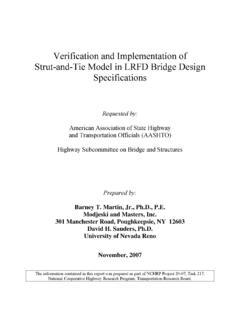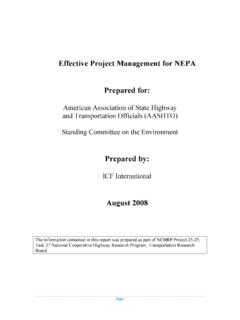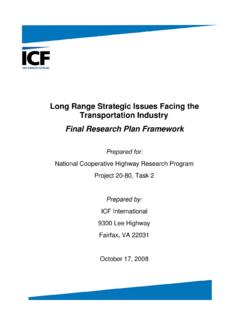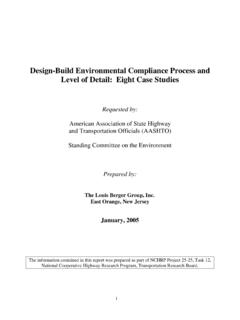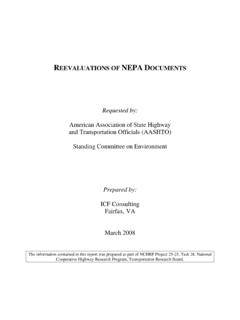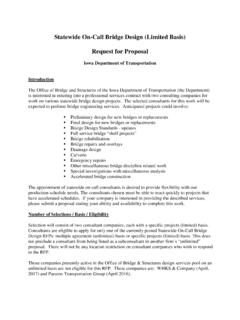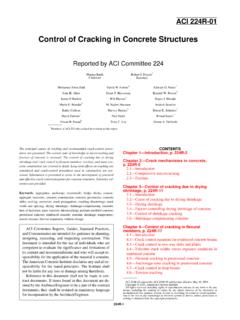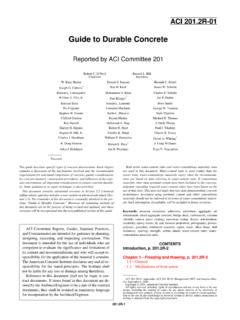Transcription of ACKNOWLEDGMENT OF SPONSORSHIP - …
1 ACKNOWLEDGMENT OF SPONSORSHIP This work was sponsored by the American Association of State Highway and Transportation Officials, in cooperation with the Federal Highway Administration, and was conducted in the National Cooperative Highway Research Program, which is administered by the Transportation Research Board of the National Research Council. DISCLAIMER This is the final draft as submitted by the research agency. The opinions and conclusions expressed or implied in the report are those of the research agency. They are not necessarily those of the Transportation Research Board, the National Research Council, the Federal Highway Administration, the American Association of State Highway and Transportation Officials, or the individual states participating in the National Cooperative Highway Research Program.
2 PART 2 DESIGN INPUTS CHAPTER 5 EVALUATION OF EXISTING PAVEMENTS FOR REHABILITATION This chapter provides an introduction to project-level pavement evaluation, guidance for data collection, and an overall condition assessment and problem definition for existing flexible and rigid pavements. INTRODUCTION Reliable and cost-effective design of a rehabilitation project requires the collection and detailed analysis of key data from the existing pavement. Such data are often categorized as follows: Traffic lane pavement condition ( , distress, smoothness, surface friction, and deflections). Shoulder pavement condition.
3 Past maintenance activities. Pavement design features ( , layer thicknesses, shoulder type, joint spacing, and lane width). Geometric design features. Layer material and subgrade soil properties. Traffic volumes and loadings. Climate. Miscellaneous factors ( , utilities and clearances). This chapter provides procedures and guidance for performing project-level evaluation of pavement structures for use in rehabilitation type selection (see PART3, Chapter 5) and in rehabilitation design (see PART 3, Chapters 6 and 7). It also provides guidance for determining those inputs that are considered essential for the different types of rehabilitation design.
4 The project-level evaluation program incorporated into this Guide covers three common pavement types flexible, rigid, and composite. It discusses the procedures used for pavement evaluation and the types of input data required for both assessing existing pavement condition and designing recommended rehabilitation alternatives. Major Aspects of Project-Level Pavement Evaluation Project-level data evaluation usually consists of a detailed analysis of all aspects of pavement condition, resulting in the identification of specific problems and their causes. The data types required for analysis range from simple data, such as the pavement design features and pavement geometrics, to detailed data obtained from destructive testing ( , asphalt concrete [AC] dynamic modulus and portland cement concrete [PCC] elastic modulus), nondestructive testing ( , deflection testing), and drainage surveys.
5 Overall pavement condition and problem definition can be determined by evaluating the following major aspects of the existing pavement: Structural adequacy (load related). Functional adequacy (user related). Subsurface drainage adequacy. Material durability. Shoulder condition. Extent of maintenance activities performed in the past. Variation of pavement condition or performance within a project. Miscellaneous constraints ( , bridge and lateral clearance and traffic control restrictions). The structural category relates to those properties and features that define the response of the pavement to traffic loads; the data will be used in mechanistic-empirical design of rehabilitation alternatives.
6 The functional category relates to the surface and subsurface characteristics and properties that define the smoothness of the roadway, or to those surface characteristics that define the frictional resistance or other safety characteristics of the pavement s surface. Subsurface drainage and material durability may affect both structural and functional condition. Shoulder condition is very important in terms of rehabilitation type selection and in affecting project cost. Variation within a project refers to areas where there is a significant variability in pavement condition. Such variation may occur along the length of the project, between lanes (truck lane versus other lanes), among cut and fill portions of the roadway, and at bridge approaches, interchanges, or intersections.
7 Miscellaneous factors, such as joint condition for jointed concrete pavements and reflection cracking for composite pavements, are important to the overall condition such pavements but should be evaluated only where relevant. Lastly, project-level pavement evaluation cannot be complete unless all possible constraints that may be encountered during rehabilitation (such as the availability of adequate bridge clearance for placing overlays and traffic control restrictions) are documented. This is a very important consideration in selecting feasible rehabilitation alternatives and for life cycle cost analysis (LCCA). Definition of Project-Level Pavement Evaluation This chapter provides overall guidance for identifying the types and root causes of distress on existing pavements.
8 It also provides information on the data required for providing a cost-effective rehabilitation design for defective pavements. As shown in figure , the pavement evaluation and rehabilitation selection and design process can be subdivided into three phases (1). For all three phases, considerable amounts of analysis and engineering judgment should be applied to define the problems of existing pavements and to develop cost-effective solutions. A detailed description of phase I (evaluation) is presented in this chapter; phase II (selection and preliminary design) is described in Chapters 5, 6, and 7 in PART 3 of this Guide.
9 Phase III (LCCA) is described in Appendix C. I: OVERALL CONDITION ASSESSMENT ANDPROBLEM DEFINITION (Part II, Chapter 5)A. COLLECT DATAB. EVALUATE DATAC. IDENTIFY CONSTRAINTSPHASE II: POTENTIAL PROBLEM SOLUTIONS(Part III, Chapters 5, 6, and 7)A. COLLECT DATAB. FEASIBLE SOLUTIONSC. DEVELOP PRELIMINARY DESIGNSPHASE III: SELECTION OF PREFERRED SOLUTION(APPENDIX C)A. COST ANALYSISB. NON-MONETARY CONSIDERATIONSC. PREFERRED REHABILITATION ALTERNATIVED. DETAILED DESIGN Figure The pavement rehabilitation selection process (1). I Overall Condition Assessment and Problem Definition (Evaluation) The first step in the pavement rehabilitation selection process involves assessing the overall condition of the existing pavement and fully defining the existing pavement problems.
10 To avoid making an inaccurate assessment of the problem, the engineer should collect and evaluate sufficient information about the pavement. High-speed nondestructive testing data such as ground penetration radar (GPR) and profile testing should be considered to assist in making decisions related to timing of the improvement and additional data collection efforts needed. Table contains a comprehensive checklist of factors designed to hone in on the problems that should be addressed. This list should be modified to suit the project s specific needs. It is vital that the agencies develop procedures and guidelines for answering the questions on their list.

